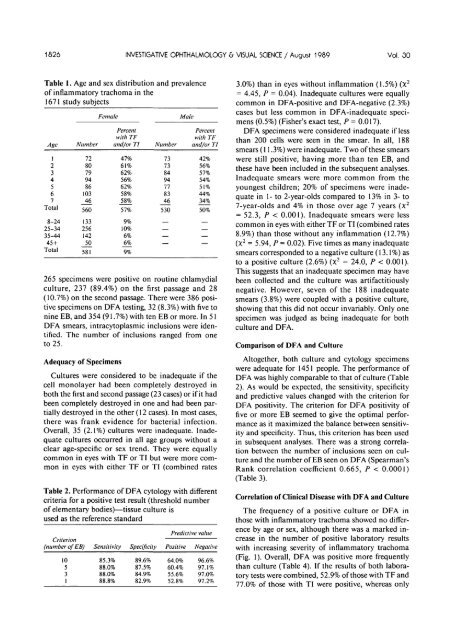The Epidemiology of Infection in Trachoma - Investigative ...
The Epidemiology of Infection in Trachoma - Investigative ...
The Epidemiology of Infection in Trachoma - Investigative ...
Create successful ePaper yourself
Turn your PDF publications into a flip-book with our unique Google optimized e-Paper software.
1826 INVESTIGATIVE OPHTHALMOLOGY & VISUAL SCIENCE / Augusr 1989 Vol. 30<br />
Table 1. Age and sex distribution and prevalence<br />
<strong>of</strong> <strong>in</strong>flammatory trachoma <strong>in</strong> the<br />
1671 study subjects<br />
Age<br />
1<br />
2<br />
3<br />
4<br />
5<br />
6<br />
7<br />
Total<br />
8-24<br />
25-34<br />
35-44<br />
45+<br />
Total<br />
Number<br />
72<br />
80<br />
79<br />
94<br />
86<br />
103<br />
46<br />
560<br />
133<br />
256<br />
142<br />
50<br />
581<br />
Female<br />
Percent<br />
with TF<br />
and/or TI<br />
47%<br />
61%<br />
62%<br />
56%<br />
62%<br />
58%<br />
58%<br />
57%<br />
9%<br />
10%<br />
6%<br />
6%<br />
9%<br />
Number<br />
73<br />
73<br />
84<br />
94<br />
77<br />
83<br />
46<br />
530<br />
—<br />
Male<br />
Percent<br />
with TF<br />
and/or TI<br />
42%<br />
56%<br />
57%<br />
54%<br />
51%<br />
44%<br />
34%<br />
50%<br />
265 specimens were positive on rout<strong>in</strong>e chlamydial<br />
culture, 237 (89.4%) on the first passage and 28<br />
(10.7%) on the second passage. <strong>The</strong>re were 386 positive<br />
specimens on DFA test<strong>in</strong>g, 32 (8.3%) with five to<br />
n<strong>in</strong>e EB, and 354 (91.7%) with ten EB or more. In 51<br />
DFA smears, <strong>in</strong>tracytoplasmic <strong>in</strong>clusions were identified.<br />
<strong>The</strong> number <strong>of</strong> <strong>in</strong>clusions ranged from one<br />
to 25.<br />
Adequacy <strong>of</strong> Specimens<br />
Cultures were considered to be <strong>in</strong>adequate if the<br />
cell monolayer had been completely destroyed <strong>in</strong><br />
both the firstand second passage (23 cases) or if it had<br />
been completely destroyed <strong>in</strong> one and had been partially<br />
destroyed <strong>in</strong> the other (12 cases). In most cases,<br />
there was frank evidence for bacterial <strong>in</strong>fection.<br />
Overall, 35 (2.1%) cultures were <strong>in</strong>adequate. Inadequate<br />
cultures occurred <strong>in</strong> all age groups without a<br />
clear age-specific or sex trend. <strong>The</strong>y were equally<br />
common <strong>in</strong> eyes with TF or TI but were more common<br />
<strong>in</strong> eyes with either TF or TI (comb<strong>in</strong>ed rates<br />
Table 2. Performance <strong>of</strong> DFA cytology with different<br />
criteria for a positive test result (threshold number<br />
<strong>of</strong> elementary bodies)—tissue culture is<br />
used as the reference standard<br />
Criterion<br />
(number <strong>of</strong>EB) Sensitivity<br />
10<br />
85.3%<br />
5<br />
88.0%<br />
3 88.0%<br />
1 88.8%<br />
Specificity<br />
89.6%<br />
87.5%<br />
84.9%<br />
82.9%<br />
—<br />
—<br />
Predictive value<br />
Positive<br />
64.0%<br />
60.4%<br />
55.6%<br />
52.8%<br />
Negative<br />
96.6%<br />
97.1%<br />
97.0%<br />
97.2%<br />
3.0%) than <strong>in</strong> eyes without <strong>in</strong>flammation (1.5%) (X 2<br />
= 4.45, P = 0.04). Inadequate cultures were equally<br />
common <strong>in</strong> DFA-positive and DFA-negative (2.3%)<br />
cases but less common <strong>in</strong> DFA-<strong>in</strong>adequate specimens<br />
(0.5%) (Fisher's exact test, P = 0.017).<br />
DFA specimens were considered <strong>in</strong>adequate if less<br />
than 200 cells were seen <strong>in</strong> the smear. In all, 188<br />
smears (11.3%) were <strong>in</strong>adequate. Two <strong>of</strong> these smears<br />
were still positive, hav<strong>in</strong>g more than ten EB, and<br />
these have been <strong>in</strong>cluded <strong>in</strong> the subsequent analyses.<br />
Inadequate smears were more common from the<br />
youngest children; 20% <strong>of</strong> specimens were <strong>in</strong>adequate<br />
<strong>in</strong> 1- to 2-year-olds compared to 13% <strong>in</strong> 3- to<br />
7-year-olds and 4% <strong>in</strong> those over age 7 years (X 2<br />
= 52.3, P < 0.001). Inadequate smears were less<br />
common <strong>in</strong> eyes with either TF or TI (comb<strong>in</strong>ed rates<br />
8.9%) than those without any <strong>in</strong>flammation (12.7%)<br />
(X 2 = 5.94, P = 0.02). Five times as many <strong>in</strong>adequate<br />
smears corresponded to a negative culture (13.1%) as<br />
to a positive culture (2.6%) (X 2 = 24.0, P < 0.001).<br />
This suggests that an <strong>in</strong>adequate specimen may have<br />
been collected and the culture was artifactitiously<br />
negative. However, seven <strong>of</strong> the 188 <strong>in</strong>adequate<br />
smears (3.8%) were coupled with a positive culture,<br />
show<strong>in</strong>g that this did not occur <strong>in</strong>variably. Only one<br />
specimen was judged as be<strong>in</strong>g <strong>in</strong>adequate for both<br />
culture and DFA.<br />
Comparison <strong>of</strong> DFA and Culture<br />
Altogether, both culture and cytology specimens<br />
were adequate for 1451 people. <strong>The</strong> performance <strong>of</strong><br />
DFA was highly comparable to that <strong>of</strong> culture (Table<br />
2). As would be expected, the sensitivity, specificity<br />
and predictive values changed with the criterion for<br />
DFA positivity. <strong>The</strong> criterion for DFA positivity <strong>of</strong><br />
five or more EB seemed to give the optimal performance<br />
as it maximized the balance between sensitivity<br />
and specificity. Thus, this criterion has been used<br />
<strong>in</strong> subsequent analyses. <strong>The</strong>re was a strong correlation<br />
between the number <strong>of</strong> <strong>in</strong>clusions seen on culture<br />
and the number <strong>of</strong> EB seen on DFA (Spearman's<br />
Rank correlation coefficient 0.665, P < 0.0001)<br />
(Table 3).<br />
Correlation <strong>of</strong> Cl<strong>in</strong>ical Disease with DFA and Culture<br />
<strong>The</strong> frequency <strong>of</strong> a positive culture or DFA <strong>in</strong><br />
those with <strong>in</strong>flammatory trachoma showed no difference<br />
by age or sex, although there was a marked <strong>in</strong>crease<br />
<strong>in</strong> the number <strong>of</strong> positive laboratory results<br />
with <strong>in</strong>creas<strong>in</strong>g severity <strong>of</strong> <strong>in</strong>flammatory trachoma<br />
(Fig. 1). Overall, DFA was positive more frequently<br />
than culture (Table 4). If the results <strong>of</strong> both laboratory<br />
tests were comb<strong>in</strong>ed, 52.9% <strong>of</strong> those with TF and<br />
77.0% <strong>of</strong> those with TI were positive, whereas only
















